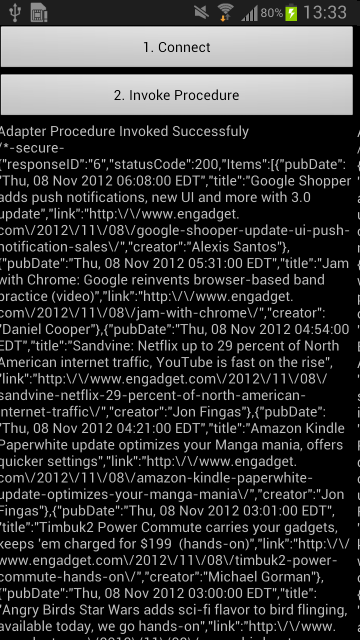Resource request from native Android applications
improve this page | report issueOverview
To create and configure an Android native project, first follow the Configuring a native Android application with the MobileFirst Platform SDK tutorial.
MobileFirst applications can access resources using the WLResourceRequest REST API.
This tutorial explains how to use the WLResourceRequest API with an HTTP adapter.
Initializing WLClient
- Create an instance of the
WLClientclass.
TheWLClientinstance requires a reference to the activity in which it is running.WLClient client = WLClient.createInstance(context); - To establish a connection to the MobileFirst Server instance, use the
connectmethod by specifying theMyConnectListenerclass instance as a parameter.The
WLClientinstance tries to connect to the MobileFirst Server according to the properties of thewlclient.propertiesfile.
After the connection is established, it invokes one of the methods of theMyConnectListenerclass. - Specify that the
MyConnectListenerclass implements theWLResponseListenerinterface.public class MyConnectListener implements WLResponseListener {The
WLResponseListenerinterface defines two methods:
-public void onSuccess (WLResponse response) { }
-public void onFailure (WLFailResponse response) { } - Use these methods to process connection success or connection failure.
Invoking an adapter procedure
After the connection is established with a MobileFirst Server instance, you can use the WLResourceRequest class to invoke adapter procedures or call any REST resources.
- Define the URI of the resource. For a JavaScript HTTP adapter:
/adapters/{AdapterName}/{ProcedureName}
URI adapterPath = new URI("/adapters/RSSReader/getFeed"); - Create a
WLResourceRequestobject and choose the HTPP Method (GET, POST, etc).
WLResourceRequest request = new WLResourceRequest(adapterPath,WLResourceRequest.GET); - Add the required parameters.
- For JavaScript-based adapters, use the
paramsparameter name to set an array of parameters.
request.setQueryParameter("params","['MobileFirst_Platform']"); - For Java adapters or other resources, you can use
setQueryParameterfor each parameter.
request.setQueryParameter("param1","value1"); request.setQueryParameter("param2","value2"); - Trigger the request with
.send().
Specify aMyInvokeListenerclass instance as a parameter.
You learn how to define this class instance in the next section.request.send(new MyInvokeListener());Other signatures, which are not covered in this tutorial, exist for the
sendmethod. Those signatures enable you to set parameters in the body instead of the query, or to handle the response with a delegate instead of a completion handler. See the user documentation to learn more.
- For JavaScript-based adapters, use the
Receiving a procedure response
After the procedure invocation is completed, the framework calls one of the methods of the MyInvokeListener class.
- Specify that the
MyInvokeListenerclass implements theWLResponseListenerinterface.public class MyInvokeListener implements WLResponseListener {The
WLClientinstance invokes theonSuccessandonFailuremethods.If the procedure invocation is successful, the
onSuccessmethod ofMyInvokeListeneris invoked. - Use that method to get the data that is retrieved from the adapter. The
responseobject contains the response data.
You can use its methods and properties to retrieve the required information.public void onSuccess(WLResponse response) { String responseText = response.getResponseText(); AndroidNativeApp.updateTextView("Adapter Procedure Invoked Successfuly\n" + responseText); } public void onFailure(WLFailResponse response) { String responseText = response.getResponseText(); AndroidNativeApp.updateTextView("Failed to Invoke Adapter Procedure\n" + responseText); }
Sample application
Click to download the MobileFirst project.
Click to download the Native project.
– The InvokingAdapterProcedures project contains a MobileFirst Native API to deploy to your MobileFirst Server instance.
– The InvokingAdapterProceduresAndroid project contains a native Android application that uses a MobileFirst native API library to communicate with MobileFirst Server.
- Make sure to update the wlclient.properties file in the native Android project with the required server settings.

Inclusive terminology note: The Mobile First Platform team is making changes to support the IBM® initiative to replace racially biased and other discriminatory language in our code and content with more inclusive language. While IBM values the use of inclusive language, terms that are outside of IBM's direct influence are sometimes required for the sake of maintaining user understanding. As other industry leaders join IBM in embracing the use of inclusive language, IBM will continue to update the documentation to reflect those changes.